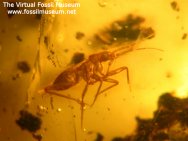Hemiptera,
the true bugs, appeared in Upper Pennsylvannian-time.
It is an enormously diverse insect Order believed to contain some 80,000 extant
species. Hemipterans have piercing and sucking mouthparts that form an artuculated
beak. The two pair of wings are hardened near the body, but membranous towards
the ends. While most are herbivores, some are predators, such as bedbugs. An assassin
fly in Latin America (cousin to the wheel bug shown above) is a vector for the protozoan that sleeping sickness that kills many people
each year.
above) is a vector for the protozoan that sleeping sickness that kills many people
each year. Hemipterans
have incomplete metamorphosis, i.e., they have three stages of life: 1) egg; 2)
nymph; and 3) adult. Nymphs appear as miniature versions of the adult except with
different coloration. As the nymph progresses through exoskeleton molts, it grows
to appear increasingly like the adult both in size and coloration. Hemiptera
means "half wing" owing to the first pair of wings being toughened and
hard, while the remainder of the first pair and a second pair are membranous.
Some entomologists combine Hemiptera and Homoptera
within the group Heteroptera. Other entomologists use the name of the Order Heteroptera
rather than Hemiptera.
Gallery
of Fossil Hemiptera Images |
 |
|
|
|
|
Uncommon
Plant Bug (Family Miridae) in Dominican Fossil Amber
Plant bugs, along with a few near relatives, have the
ability to walk on spider webs, allowing them to feed
on the spider’s leavings. |
Coming
from the famous Crato
Formation of Brazil, this Cretaceous Hemiptera exhibits
incredible 3D preservation. Hemiptera The true bugs possess
a stylet by which they secure their food by piercing the
skin of other insects or plants to suck fluids. |
Coming
from the Lower Cretaceous of Liaoning
Province, China, this is a member of the Miridae, or plant
bugs, the largest family of extant true bugs. This is
a fine specimen with incredible detail preserved, particularly
in the wings, from the dim past of 125 million years ago.
Notice also the piercing mouthparts by which the insect
obtained a meal. |
A
wonderfully preserved water strider (Order: Hemiptera;
Family: Gerridae), trapped inside fossil maber from the
Andes Mountains of Colombia, South America |
|
|
|
|
|
Nymphal
form of a rare ambush bug in fossil amber. While Hemipterans
usually suck plants, the ambush bug, uses its piercing
mouthparts to suck the lifeblood from other insects (yecchh!). |
This
is an incredibly well-preserved, 6 mm long, member of
the Order Hemiptera Family Reduviidae, or Assassin Bugs,
in Colombian amber. They are also called Resin Bugs, a
term given them due to their habit of lurking around resin
deposits lying in wait for their favorite prey: stingless
bees. The bees come to the resin to gather samples which
are used in construction of their nests. The assassin
bugs often will attach some sticky resin to their forelegs
(see the closeups) much as a wide receiver will apply
stickum to catch a football. |
Large
Cretaceous Giant Water Bug (Belostomatidae) Fossil Insect
from Brazil. |
|
|
|
A
stinkbug in Colombian amber. A member of Family Pentatomidae,
Stink bugs are named for excreting a foul smelling substance
from a pore on each side of their thorax. These bugs often
have symbiotic relationships with bacteria that aid the
insect in the production of nutrients. |
|
|
|
|
| |









